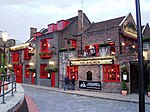The Clink

The Clink was a prison in Southwark, England, which operated from the 12th century until 1780. The prison served the Liberty of the Clink, a local manor area owned by the Bishop of Winchester rather than by the reigning monarch. As the Liberty owner, the Bishop kept all revenues from the Clink Liberty, and could put people in prison for failing to make their payments. As the Bishop, he could also imprison heretics. The Clink prison was situated next to the Bishop's London-area residence of Winchester Palace. The Clink was possibly the oldest men's prison and probably the oldest women's prison in England.It is uncertain whether the prison derived its name from, or bestowed it on, the Liberty that it served. The origins of the name "The Clink" are possibly onomatopoeic, deriving from the sound of striking metal as the prison's doors were bolted, or the rattling of the chains the prisoners wore.The name has become slang as a generic term for prison or a jail cell.
Excerpt from the Wikipedia article The Clink (License: CC BY-SA 3.0, Authors, Images).The Clink
Southwark Bridge Road, London Borough (London Borough of Southwark)
Geographical coordinates (GPS) Address Nearby Places Show on map
Geographical coordinates (GPS)
| Latitude | Longitude |
|---|---|
| N 51.507077777778 ° | E -0.091930555555556 ° |
Address
Roman Southwark
Southwark Bridge Road
SE1 0EX London, Borough (London Borough of Southwark)
England, United Kingdom
Open on Google Maps










